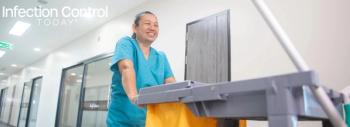
- Infection Control Today, September/October 2023 (Vol. 27 No. 7)
- Volume 27
- Issue 7
Protecting HCWs: Plague Doctor's Masks to the Personal Protective Equipment of Tomorrow
Plague doctors' historical attire was an early form of PPE. While modern PPE has improved, the quest for better, more comfortable protection continues as we aim for a future where health care workers can provide care confidently.
Centuries ago, how strange it must have been to watch the neighborhood physician stroll down the street through the fog of the early morning, dressed in a bird-like mask and cloaked in a long black robe. How terrifying for the children who watched these ghastly figures enter and exit the houses of their dying neighbors. And how somber for these to be the last faces gazed upon by those who would succumb to the bubonic plague. I’ve always been fascinated with the attire worn by those tending to patients during the 16th and 17th century plague epidemics. Now a popular Halloween costume, this attire had a functional purpose for the wearer despite its macabre appearance.
Masks were stuffed with herbs and perfumes to protect the individual fully cloaked in black from the so-called poisonous air suspected to cause disease. But technology at the time and the ignorance of germ theory would lead to an ineffective design that would fall short of offering the protective value the outfit sought. Although the plague mask and cloak likely provided some degree of protection to the wearer, it was marginal at best. This early form of personal protective equipment (PPE) used the best technology and knowledge available then, yet it fell short.
What about present day? It always makes me wonder: What is it that medical science does not yet know? What technology awaits us to improve our design and use of PPE?
We have undoubtedly come a long way from the plague doctors of Venice in our design and use of PPE. Our PPE is better engineered to provide a barrier to pathogens, and our knowledge of germ theory has revolutionized how we approach and use personal protective equipment. Technology has drastically improved our ability to prevent and control the spread of infectious diseases. Yet, health care workers are still at a higher risk of acquiring infection despite medical science and bioengineering advancements. So, if I could, for a moment, imagine a future where health care workers wear PPE that renders them invincible, PPE that provides complete protection from harmful pathogens, PPE so comfortable, we look forward to using it! PPE doesn’t contribute to medical waste because it is durable, resistant to pathogens, and, therefore, reusable. The innumerable opportunities that may await us in the future of medical science are vast and exciting—these promises of more durable, comfortable, and user-friendly PPE echo from the hallways of bioengineering schools. Every day, new ideas are being imagined, invented, and tested to solve the complex solutions that plague health care today.
I hope that my children’s children will someday look back on today’s medicine and marvel at how much technology has advanced the science of preventing and controlling disease. I hope health care workers will never again have to fear the virus or be uncomfortable for hours while providing lifesaving care. Who knows, reader, perhaps you will be the one to introduce the next advancement in PPE. Perhaps you will be who they talk about in the history books.
Articles in this issue
about 2 years ago
ICT's Product Locator: September/October 2023about 2 years ago
Bug of the Month: I Make Tummies Hurtabout 2 years ago
Infection Prevention in the NICU: A Changing Landscapeabout 2 years ago
Ventilation and the Risk of Health Care–Associated Infectionsabout 2 years ago
I’m Not Just an Infection Preventionistover 2 years ago
AHE Exchange Conference & Solution Center 2023 Reviewover 2 years ago
Creating the Framework of Patient SafetyNewsletter
Stay prepared and protected with Infection Control Today's newsletter, delivering essential updates, best practices, and expert insights for infection preventionists.






